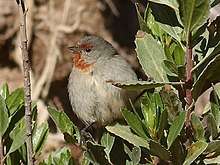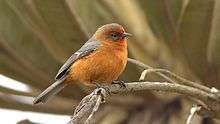Conirostrum
Typical conebills belong to the tanager genus Conirostrum. They are small tanagers (9–14 cm) found in the forests of South America. They feed in pairs or small flocks by gleaning insects from foliage.
| Conebills | |
|---|---|
 | |
| Chestnut-vented conebill (Conirostrum speciosum) | |
| Scientific classification | |
| Kingdom: | Animalia |
| Phylum: | Chordata |
| Class: | Aves |
| Order: | Passeriformes |
| Family: | Thraupidae |
| Genus: | Conirostrum d'Orbigny & Lafresnaye, 1838 |
| Species | |
|
10, see text | |
The genus consists of two rather distinct subgenera:[1] The first, Ateleodacnis, possibly deserving full generic status, is confined to lowland areas. They are mostly grey in colour and inhabit deciduous woodlands, mangroves or riverbank habitats. The second group, the nominate Conirostrum subgenus, inhabits the forests of the Andes. They are somewhat more colourful combining grey or blue backs with rufous underparts. Their thin bills led to them being formerly classified as wood-warblers or honeycreepers but genetic data places them firmly in the tanager family and they are now generally considered to belong in the Thraupidae.
The related giant conebill is more distinct: it belongs to the monotypic genus Oreomanes. The record of an apparent intergeneric hybrid with white-browed conebill (Oreomanes fraseri x Conirostrum ferrugineiventre) suggests the giant conebill may belong in Conirostrum possibly in the nominate subgenus.[2]
Species list
| Subgenus | Image | Common name | Scientific name | Distribution |
|---|---|---|---|---|
| Ateleodacnis |  |
Chestnut-vented conebill | Conirostrum speciosum | Argentina, Bolivia, Brazil, Colombia, Ecuador, French Guiana, Guyana, Paraguay, Peru, Suriname, and Venezuela. |
_(8079767610).jpg) |
White-eared conebill | Conirostrum leucogenys | Colombia, Panama, and Venezuela | |
.jpg) |
Bicolored conebill | Conirostrum bicolor | Colombia, Venezuela and Trinidad south and east to the Guianas, northeast Peru and Brazil. | |
 |
Pearly-breasted conebill | Conirostrum margaritae | Brazil and Peru. | |
| Conirostrum |  |
Cinereous conebill | Conirostrum cinereum | Bolivia, Chile, Colombia, Ecuador, and Peru. |
 |
Tamarugo conebill | Conirostrum tamarugense | northern Chile and is a vagrant to southern Peru | |
.jpg) |
White-browed conebill | Conirostrum ferrugineiventre | Bolivia and Peru | |
 |
Rufous-browed conebill | Conirostrum rufum | Colombia and far western Venezuela | |
.jpg) |
Blue-backed conebill | Conirostrum sitticolor | Bolivia, Colombia, Ecuador, Peru, and Venezuela. | |
.jpg) |
Capped conebill | Conirostrum albifrons | Bolivia, Colombia, Ecuador, Peru, and Venezuela | |
Footnotes
- Ridgely & Tudor (1989), pp. 208–212, 222–224
- Schulenberg (1985)
References
- Beecher, W. J. 1951. Convergence in the Coerebidae. Wilson Bull. 63: 274–287.
- Burns, Kevin J.; Hackett, Shannon J.; Klein, Nedra K. (June 2002). "PHYLOGENETIC RELATIONSHIPS AND MORPHOLOGICAL DIVERSITY IN DARWIN'S FINCHES AND THEIR RELATIVES". Evolution. 56 (6): 1240–1252. doi:10.1111/j.0014-3820.2002.tb01435.x. PMID 12144023.
- J. Burns, Kevin; J. Hackett, Shannon; K. Klein, Nedra (December 2003). "Phylogenetic relationships of Neotropical honeycreepers and the evolution of feeding morphology". Journal of Avian Biology. 34 (4): 360–370. CiteSeerX 10.1.1.486.3107. doi:10.1111/j.0908-8857.2003.03171.x.
- Fjeldså, J., & N. Krabbe. 1990. Birds of the High Andes. Zoological Museum, Univ. Copenhagen, Copenhagen, Denmark.
- Hellmayr, C. E. 1935. Catalogue of birds of the Americas. Field Mus. Nat. Hist. Publ., Zool. Ser., vol. 13., pt. 8.
- Lowery, G. H., JR., & B. L. Monroe, JR. 1968. Family Parulidae. pp. 3–93 in "Check-list of birds of the World, Vol. 14" (Paynter R. A., Jr., ed.). Museum of Comparative Zoology, Cambridge, Massachusetts.
- Lovette, I. J.; Bermingham, E. (2002). "WHAT IS A WOOD-WARBLER? MOLECULAR CHARACTERIZATION OF A MONOPHYLETIC PARULIDAE". The Auk. 119 (3): 695. doi:10.1642/0004-8038(2002)119[0695:wiawwm]2.0.co;2.
- Meyer de Schauensee, R. 1970. A guide to the birds of South America. Livingston Publishing Co., Wynnewood, Pennsylvania.
- Ridgely, R. S., & G. Tudor. 1989. The birds of South America, vol. 1. Univ. Texas Press, Austin.
- Ridgway, R. 1902. The birds of North and Middle America. Bull. U.S. Nat. Mus., no. 50, pt. 2.
- Schulenberg, T. S. 1985. An intergeneric hybrid conebill (Conirostrum X Oreomanes) from Peru. pp. 390–395 in "Neotropical Ornithology" (P. A. Buckley et al., eds.), Ornithol. Monogr. No. 36.
- Storer, R. W. 1970a. Subfamily Thraupinae. pp. 246–408 in "Check-list of birds of the World, Vol. 13" (Paynter R. A., Jr., ed.). Museum of Comparative Zoology, Cambridge, Massachusetts.
- Wetmore, A., R. F. Pasquier, & S. L. Olson. 1984. The birds of the Republic of Panamá, part 4. Smithsonian Misc. Collect., vol. 150.
- Zimmer, John Todd (1942). "Studies of Peruvian birds, No. 43. Notes on The genera Dacnis, Xenodacnis, Coereba, Conirostrum, and Oreomanes". American Museum Novitates. 1193: 1–16. hdl:2246/4800.